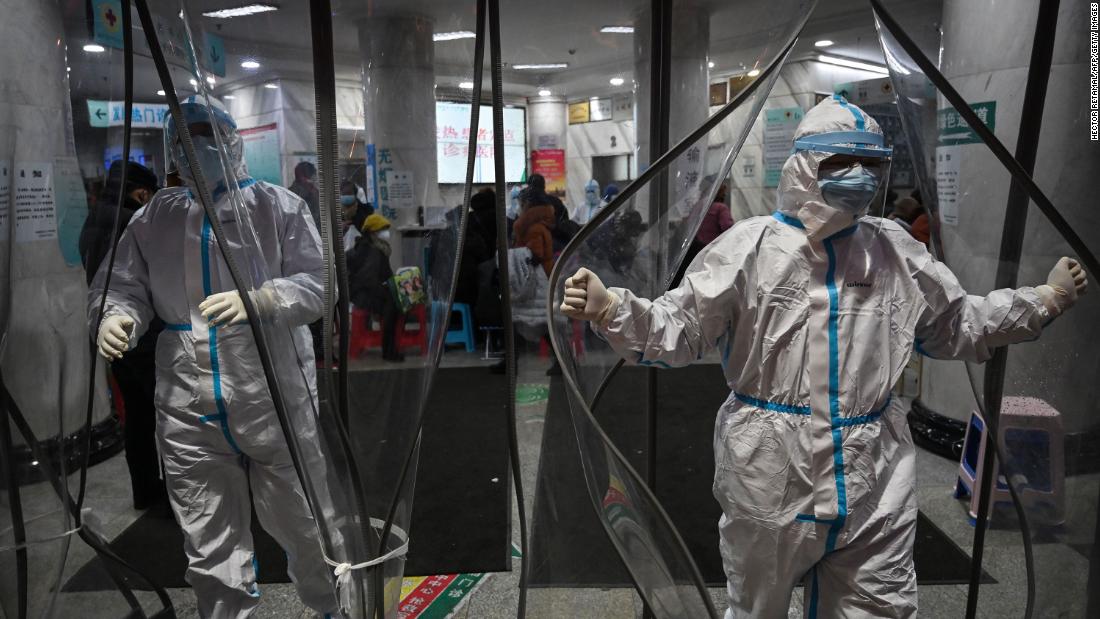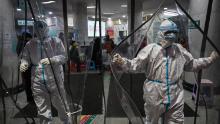[ad_1]
After all, Chinese authorities were saying that the outbreak was “preventable and controllable.”
On Monday, preliminary results showed Shi could also be infected with the virus.
But she is more worried for her family — for her 67-year-old father who also appears to have the virus too, and for her mother who has been uprooted to what she describes as an older, inferior hospital building, to make way for the rush of coronavirus patients.
Shi, and others like her, have become victims of a public health care crisis. Over the past few days, CNN has spoken to patients, medical staff and experts who have told of delays in testing for the virus, in telling the public the true nature of the virus’ spread, and of an already overburdened health system creaking under the enormous weight of a rapidly expanding outbreak.
The start of an outbreak
When Shi arrived in China on January 10, the coronavirus outbreak was already well underway.
On January 7, Chinese scientists identified the pathogen as a novel coronavirus. Two days later, the first death occurred.
But it wasn’t until over a week later, Shi says, that a doctor pulled her aside. The situation wasn’t good, the doctor said, and everyone needed to wear a face mask.
“I saw this doctor going to patients’ families one by one, privately,” Shi said. “It was only then when we realized how serious this was getting.”
On January 17, there were 41 confirmed cases in Wuhan. By January 20, the total number of confirmed cases jumped to 201 across China, with three dead.
While the virus was discussed widely online over that period, it didn’t make the front page of official state newspaper, the People’s Daily, until January 21.
Less than three weeks later, it was a different story.
Under Chinese law, local governments need to report an epidemic outbreak with unknown causes to the national health department and get approval from the State Council before they can make an announcement.
But Mary Gallagher, the director of the Center for Chinese studies at the University of Michigan and an expert in Chinese politics, believes that the numbers of infections was likely under-reported by Wuhan authorities in December and the start of January.
“It’s not even necessarily an insidious command from the central government — it’s almost like an implicit norm, that bad news is to be covered up as much as possible,” she said.
Chinese President Xi Jinping said Tuesday that the government was releasing information in a “transparent and responsible manner.”
“The Chinese people are engaging in a serious battle against the outbreak of the new coronavirus pneumonia. People’s lives and health are always the first priority for the Chinese government, and the prevention and control of the epidemic is the most important task at present, so I have been directing and deploying the works myself.”
Around the same time as the jump in cases, two men in full hazmat suits barged into Shi’s mother’s ward, demanding they move to another floor within 30 minutes. “They gave no reasoning, just the order,” Shi said. “It was only when I asked the hospital staff, and they told me that all patients on this floor — like my mum, they are all cancer patients — must be evacuated to make space for handling novel coronavirus.”
Slow testing
The truth about the virus also came too late for other patients in Wuhan’s hospitals.
By January 26, Shi began to have a fever — one of the symptoms of the novel coronavirus. She went to the hospital’s fever clinic where she found over 20 patients, all waiting to be tested by one doctor.
She says she was given three tests — a nasal swipe to rule out the flu, a CT scan to compare her lungs against those of infected patients, and a blood test. After nine hours of tests and waiting for results she says the doctor told her that she had coronavirus, but because he could not give her the fourth and most definitive test, she could only be considered a suspected patient. Her 67-year-old father is in the same situation.
Shi called hospitals all over Wuhan, trying in vain to find one with the confirmation test — a reagent test which chemically tests for the virus.
For now, Shi and her father are not counted in the official statistics of people infected.
John Nicholls, a professor in pathology at the University of Hong Kong (HKU), said it was no surprise that Shi could have caught the virus in hospital. He points out viruses can easily spread within a hospital if doctors don’t take proper precautions.
Others, like Shi, have experienced delays in tests or have struggled to get tested at all.
One Wuhan resident who asked to be referred to as Leya as she fears government reprisals for speaking out said she and her young son have spent days waiting to hear if they have coronavirus. They have had a CT scan and a nucleic acid test — a laboratory examination to identify a virus. They still haven’t got confirmation of coronavirus — and until they do, they cannot be admitted to hospital. Her husband, his parents and her parents are already in hospital with the virus, and she is convinced that she and her son are likely to have the virus, too.
“I think I might have been infected,” Leya said fearfully. “I don’t know, everyday I’m getting pains around my heart.”
Dora Jiang’s 72-year-old uncle — who is based in Wuhan — is in a similar position. He went to a dedicated coronavirus hospital, but he says they delayed testing him for days and would not admit him until he receives a formal diagnosis, said Jiang, who spoke with CNN from her home in Germany.
These reports of test delays come amid assurances from Chinese manufacturer Shanghai ZJ Bio-Tech that it can produce enough testing kits to meet nationwide demand. According to state media reports on Monday, the company said it can produce 8,000 boxes per day and has enough raw materials in stock to make testing kits for 2 million people.
On Tuesday evening, Wuhan’s Communist Party chief Ma Guoqiang acknowledged that before mid-January, samples had to be sent to the Chinese Center for Disease Control and Prevention (China CDC) in Beijing. From mid-January, Wuhan was able to test about 300 cases a day, he said. China CDC says it is using a test known as fluorescent RT-PCR to detect the virus, which can be done via a nasal swab, blood, urine, or a serum specimen.
HKU’s Nicholls said that the PCR rapid test could be done in a couple of hours. He said the nasal swab was worthwhile to exclude ordinary flu, but he thought both a chest X-ray and blood tests to check for an increase in inflammatory cells would be a waste of resources.
The delays in testing can mean patients miss out on treatment but may also mean the scale of the problem is worse than we know.
As Gallagher from the University of Michigan puts it: “I don’t think the numbers that are coming out now are inaccurate because of deliberate under-reporting, I think they may be under-reported because of a lack of capacity to test.”
‘I feel so powerless’
It’s not just testing kits that places like Wuhan are short of. Authorities there have asked for more supplies, and announced they would build two new hospitals in a week to increase the city’s capacity to fight the outbreak.
According to a nurse in Wuhan who asked not to be identified for fear of professional repercussions, staff are overwhelmed, resources are running low, and there are no beds. There are so few hazmat suits that staff disinfect them at the end of their shift to wear again the next day, she said. Around 30 of the 500 medical staff at her hospital are now sick and admitted to hospital, and others — including her — have self-quarantined at home.
“There really are a lot of people who can’t get admitted, but there’s no point in blaming the nurses. There are no beds, no resources. Are we supposed to just fight this battle bare-handed?” she said. “Right now, loads of medical staff are at breaking point … I see my sisters charging toward the front line and I feel so powerless.”
“If you have a fever, don’t come to the hospital,” she posted on WeChat, a Chinese social media platform. Unless someone is suffering from serious conditions, she believes they should stay away from hospitals as they risk infecting others and causing unnecessary strain on the health system.
System under pressure
Even before the Wuhan coronavirus outbreak, China’s health care system was under pressure, says Chen Xi, an assistant professor at Yale School of Public Health.
There is still a large divide between the care provided at urban hospitals in the most developed cities — like Wuhan — and the care in rural hospitals, Chen said.
People in rural areas often travel huge distances to access better care, leading to even more overcrowding at urban hospitals. Particularly at this time of year, hospitals in places like Wuhan would already be extremely busy because it’s flu season, Chen added.
Wuhan may be struggling, but as a major city, its hospitals are relatively good compared to others in China, said Gallagher.
It’s plausible that the situation could be even worse in smaller centers where there is lower quality of care. Around 46 million people live in the 14 cities other than Wuhan under travel restrictions in Hubei province, and all those places have less developed health services than the provincial capital.
Many of those people might have otherwise traveled to Wuhan for care — but now, they will have to stay put. In WeChat groups seen by CNN, there are already discussions over regional hospitals lacking supplies.
Health care inequality could also be a problem for China’s migrant workers, who have returned home over the Lunar New Year period, Gallagher said. They may be unable to afford health care in the urban center where they work, but health care services could be inadequate in the rural area they are from.
For now, there is little people like Shi can do.
Shi and her father self-quarantined themselves at home this week, and were too afraid to visit Shi’s mother lest they infect others.
“My dad really wants to go and visit mum, but we both seem to have got the virus. We can’t go. Our hearts are extremely conflicted,” she said. “I am less worried about myself — I’m more worried for my father, because it seems that the elderly are more vulnerable to this disease. I just hope that a hospital can take him in first.”
Shi’s father was admitted to hospital Thursday, but Shi is still at home. Earlier this week, a hospital worker told Shi that they don’t have space for her and her father. When Shi asked what kind of patient would be admitted, she says the staff member responded: “We will admit (them) if they’re dying.”
CNN’s Julia Hollingsworth wrote and reported from Hong Kong. Yuli Yang reported from Hong Kong. Xiong Yong and Natalie Thomas reporting from Beijing.
[ad_2]
Source link








